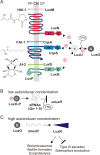Single cell analysis of Vibrio harveyi uncovers functional heterogeneity in response to quorum sensing signals
- PMID: 22985329
- PMCID: PMC3511230
- DOI: 10.1186/1471-2180-12-209
Single cell analysis of Vibrio harveyi uncovers functional heterogeneity in response to quorum sensing signals
Abstract
Background: Vibrio harveyi and closely related species are important pathogens in aquaculture. A complex quorum sensing cascade involving three autoinducers controls bioluminescence and several genes encoding virulence factors. Single cell analysis of a V. harveyi population has already indicated intercellular heterogeneity in the production of bioluminescence. This study was undertaken to analyze the expression of various autoinducer-dependent genes in individual cells.
Results: Here we used reporter strains bearing promoter::gfp fusions to monitor the induction/repression of three autoinducer-regulated genes in wild type conjugates at the single cell level. Two genes involved in pathogenesis - vhp and vscP, which code for an exoprotease and a component of the type III secretion system, respectively, and luxC (the first gene in the lux operon) were chosen for analysis. The lux operon and the exoprotease gene are induced, while vscP is repressed at high cell density. As controls luxS and recA, whose expression is not dependent on autoinducers, were examined. The responses of the promoter::gfp fusions in individual cells from the same culture ranged from no to high induction. Importantly, simultaneous analysis of two autoinducer induced phenotypes, bioluminescence (light detection) and exoproteolytic activity (fluorescence of a promoter::gfp fusion), in single cells provided evidence for functional heterogeneity within a V. harveyi population.
Conclusions: Autoinducers are not only an indicator for cell density, but play a pivotal role in the coordination of physiological activities within the population.
Figures




Similar articles
-
The phosphorylation flow of the Vibrio harveyi quorum-sensing cascade determines levels of phenotypic heterogeneity in the population.J Bacteriol. 2015 May;197(10):1747-56. doi: 10.1128/JB.02544-14. Epub 2015 Mar 9. J Bacteriol. 2015. PMID: 25755191 Free PMC article.
-
Quorum sensing regulates type III secretion in Vibrio harveyi and Vibrio parahaemolyticus.J Bacteriol. 2004 Jun;186(12):3794-805. doi: 10.1128/JB.186.12.3794-3805.2004. J Bacteriol. 2004. PMID: 15175293 Free PMC article.
-
A sensitive fluorescence reporter for monitoring quorum sensing regulated protease production in Vibrio harveyi.J Microbiol Methods. 2011 Feb;84(2):189-93. doi: 10.1016/j.mimet.2010.11.017. Epub 2010 Dec 1. J Microbiol Methods. 2011. PMID: 21129419
-
Bacterial quorum-sensing network architectures.Annu Rev Genet. 2009;43:197-222. doi: 10.1146/annurev-genet-102108-134304. Annu Rev Genet. 2009. PMID: 19686078 Free PMC article. Review.
-
Oxazaborolidine derivatives inducing autoinducer-2 signal transduction in Vibrio harveyi.Bioorg Med Chem. 2008 Feb 15;16(4):1596-604. doi: 10.1016/j.bmc.2007.11.032. Epub 2007 Nov 17. Bioorg Med Chem. 2008. PMID: 18053731 Review.
Cited by
-
You are what you talk: quorum sensing induces individual morphologies and cell division modes in Dinoroseobacter shibae.ISME J. 2013 Dec;7(12):2274-86. doi: 10.1038/ismej.2013.107. Epub 2013 Jul 4. ISME J. 2013. PMID: 23823498 Free PMC article.
-
The 9H-Fluoren Vinyl Ether Derivative SAM461 Inhibits Bacterial Luciferase Activity and Protects Artemia franciscana From Luminescent Vibriosis.Front Cell Infect Microbiol. 2018 Nov 8;8:368. doi: 10.3389/fcimb.2018.00368. eCollection 2018. Front Cell Infect Microbiol. 2018. PMID: 30467537 Free PMC article.
-
Maximizing Growth Yield and Dispersal via Quorum Sensing Promotes Cooperation in Vibrio Bacteria.Appl Environ Microbiol. 2018 Jul 2;84(14):e00402-18. doi: 10.1128/AEM.00402-18. Print 2018 Jul 15. Appl Environ Microbiol. 2018. PMID: 29728393 Free PMC article.
-
Quorum sensing going wild.iScience. 2023 Sep 22;26(10):108000. doi: 10.1016/j.isci.2023.108000. eCollection 2023 Oct 20. iScience. 2023. PMID: 37829197 Free PMC article. Review.
-
Collective decision-making in microbes.Front Microbiol. 2014 Mar 3;5:54. doi: 10.3389/fmicb.2014.00054. eCollection 2014. Front Microbiol. 2014. PMID: 24624121 Free PMC article.
References
Publication types
MeSH terms
Substances
LinkOut - more resources
Full Text Sources
Research Materials

